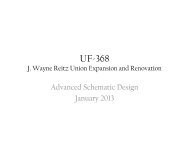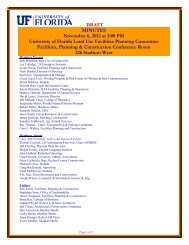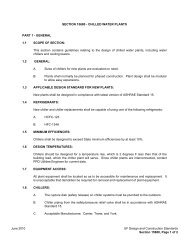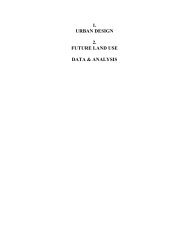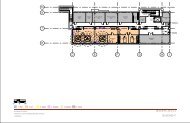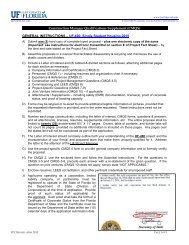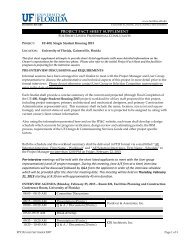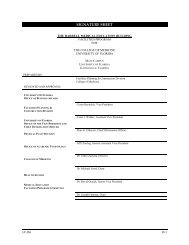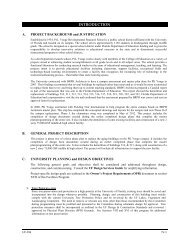Project Fact Sheet - UF-Facilities Planning & Construction ...
Project Fact Sheet - UF-Facilities Planning & Construction ...
Project Fact Sheet - UF-Facilities Planning & Construction ...
Create successful ePaper yourself
Turn your PDF publications into a flip-book with our unique Google optimized e-Paper software.
www.facilities.ufl.edu<br />
BUSINESS AFFAIRS FACILITIES PLANNING AND CONSTRUCTION<br />
PROJECT FACT SHEET<br />
FOR PROFESSIONAL CONSULTANTS<br />
PROJECT: SM-5635, CHP and Energy Feasibility Study<br />
LOCATION: University of Florida, Main Campus (Gainesville)<br />
A. OWNER FACTS:<br />
The University of Florida (Gainesville, FL) is a major public land-grant research university. The<br />
state's oldest, largest, and most comprehensive university, the University of Florida (<strong>UF</strong>) is<br />
among the nation's most academically diverse public universities. The University has a long<br />
history of established programs in international education, research, and service. It is one of only<br />
17 public land-grant universities nationwide and the only university in Florida belonging to the<br />
Association of American Universities. With more than 50,000 students, the University of Florida<br />
is now one of the five largest universities in the nation.<br />
The main <strong>UF</strong> campus includes 2,000 acres with more than 900 buildings, including 170 with<br />
classrooms and laboratories. The northeast corner of campus is listed as a historic district on the<br />
National Register of Historic Places. The University’s extensive capital improvement program<br />
has resulted in facilities ideal for 21st century research, including the McKnight Brain Institute;<br />
the Health Professions, Nursing and Pharmacy Building; the Cancer and Genetics Research<br />
Complex; and the Nanoscale Research Facility. <strong>UF</strong>'s current facilities have a book value of more<br />
than $1 billion and a replacement value of $2 billion.<br />
For any additional information about the University of Florida, please visit the University’s web<br />
page at www.ufl.edu.<br />
B. PROJECT BACKGROUND:<br />
CHP, Steam, and Electricity<br />
<strong>UF</strong> signed two agreements in June 1992 with Florida Power Corporation (now Progress Energy<br />
Florida / Duke Power) – an agreement regarding steam and electricity sales and a sublease<br />
agreement. Under the terms of these agreements, Florida Power agreed to:<br />
Install a 47 megawatt (MW) combined heat and power (CHP) or “co-generation” plant on the<br />
<strong>UF</strong> campus to serve as the principle source of 250 psi steam; and<br />
Operate & maintain two University-owned standby boilers in the Rabon Plant.<br />
The 1992 agreements expire December 2014, presenting an opportunity for <strong>UF</strong> to extend the<br />
agreement, negotiate revised terms, or have Progress Energy remove the CHP plant by the end of<br />
2015.<br />
The CHP, which is Located on Mowry Road near the Health Science Center, generates electricity<br />
that is connected back to the Progress Energy grid and uses waste heat from a General Electric<br />
LM6000 series gas turbine (scheduled to be replaced in Spring 2013) to produce steam through a<br />
heat recovery steam generator. The CHP steam generator has a capacity of 220,000 lbs/hr and<br />
delivers steam to the <strong>UF</strong>-owned Weil Plant at 250 psi and the <strong>UF</strong>-owned Rabon Plant at 250 psig<br />
and 70 psi. Steam is then distributed at 70 psi across campus through a <strong>UF</strong>-owned and <strong>UF</strong>maintained<br />
underground steam & condensate piping distribution system. This steam is the<br />
principal source of critical thermal energy once converted at the buildings to heating hot water<br />
and domestic hot water, but is also used in its raw form for autoclaves and other such equipment.<br />
FPC REVISED: NOVEMBER 2009 PAGE 1 OF 7
Steam demand ranges from 40,000 lbs/hr to 210,000 lbs/hr depending on the time of year,<br />
building type & size, and other factors. The CHP uses <strong>UF</strong> wastewater for cooling water.<br />
The Lacy Rabon, Jr. Chilled Water Plant – formerly called Heat Plant #2 – houses (2) natural gas<br />
and fuel oil standby boilers – Boiler #4 (circa 1972; nameplate 40,000 lb/hr) and Boiler #5 (circa<br />
1977; nameplate 120,000 lb/hr) – that provide steam to approximately 142 buildings on campus<br />
when the Progress Energy CHP is out of service for maintenance or repairs. The actual total<br />
capacity of the standby boilers is, which is well below the 210,000 lb/hr campus peak demand.<br />
To help close the gap between the actual capacity of these boilers (roughly 155,000 lbs/hr) and<br />
the peak demand (210,000 lb/hr), <strong>UF</strong> recently installed utility connections at the Rabon Plant for<br />
a temporary 60,000 lb/hr boiler and intends to replace Boiler #4 with a new 80,000 lb/hr boiler by<br />
Spring 2014, the 100% construction documents for which have already completed by RMF<br />
Engineering (Baltimore, MD).<br />
The <strong>UF</strong> campus is fed by three Progress Energy electric substations, which in turn feed 23 kV or<br />
12.47 kV power to <strong>UF</strong>-owned substations that reduce the distribution voltage from to 4.16 kV,<br />
13.8 kV, or 12.47 kV. Electrical demand ranges from 35 MW to 75MW.<br />
CHP Controls & Monitoring<br />
The plant uses a Foxboro Digital Control System (DCS) for control, monitoring, and<br />
trending/reporting. This system allows for instant visualization of operating conditions and<br />
efficiencies, periodic reports, and historic analysis of performance.<br />
Background Documents<br />
See the project website for general/background information regarding the CHP and utility<br />
infrastructure. Supporting data and additional documents will be made available to the shortlisted<br />
consultants in advance of the interviews.<br />
C. PROJECT DESCRIPTION:<br />
An experienced consultant is sought to analyze present conditions and evaluate potential future<br />
alternatives for the procurement, generation, delivery, and use of reliable, sustainable, efficient,<br />
and cost-effective distributed utilities across the main <strong>UF</strong> campus – specifically, steam and<br />
electricity. Alternatives may include, but are not restricted to, renegotiating a more cost effective<br />
utility rate structure, procurement and operation of the existing CHP facility, or installation of<br />
new CHP facilities and/or other technologies best suited to serve the University's long term needs.<br />
The selected firm will initially provide feasibility study services, financial and life cycle cost<br />
analyses, conceptual design services, and cost estimating services for fees estimated between<br />
$150,000 and $200,000, but may be further contracted to provide full design, construction<br />
administration, or other consulting services.<br />
The selected consultant shall conduct research, interviews, site visits, and meetings and develop<br />
data analysis, cost estimates, and conceptual design documents as needed to produce a<br />
comprehensive, investment-grade feasibility study that <strong>UF</strong> can use to make informed decisions<br />
regarding the CHP and long-term generation of steam.<br />
The feasibility study shall include an assessment of options for generating steam – with and<br />
without the CHP – and a more thorough development of the option deemed to provide the best<br />
long-term solution for <strong>UF</strong>. Such options may include the installation of new plant(s) and<br />
equipment, such as combined heat & power gas turbine(s) with heat recovery steam generator(s),<br />
steam boilers, and other steam or steam + electricity-generating equipment.<br />
FPC REVISED: NOVEMBER 2009 PAGE 2 OF 7
Specific tasks include:<br />
1. Serving as <strong>UF</strong>’s technical advisor/agent on supply-side energy generation and procurement<br />
strategies, with consideration given to fiscal, operational, sustainability, and regulatory<br />
factors.<br />
2. Making recommendations for new or renegotiated steam & electricity sales and sublease<br />
agreements with Progress Energy or other utility provider(s), including specific terms and<br />
requirements that account for changes since the 1992 agreement was executed; are more<br />
considerate of existing and future campus conditions; are in concert with <strong>UF</strong>’s broader energy<br />
efficiency and sustainability goals; and account for future regulatory changes likely to occur<br />
over the next 50 years.<br />
3. Analyzing existing plant/systems performance data and interviewing <strong>UF</strong> staff – including<br />
Physical Plant Division managers and operators – as needed to develop a complete<br />
understanding of existing conditions, facilities, and considerations.<br />
4. Analyzing current and projected campus steam, electrical, and natural gas demands.<br />
5. Reviewing prior related studies, reports, and other data.<br />
6. Developing and analyzing ideas for improving overall efficiency and reliability of the steam<br />
system, including, but not limited to:<br />
Options that take advantage of the energy transfer in the pressure drop of steam delivered<br />
to the <strong>UF</strong> steam network at 70 psi from the Progress Energy CHP at 250 psi (steam<br />
backpressure turbine chiller(s), backpressure turbine electric generator, etc.)<br />
Additional steam-powered electrical generators and chillers to take advantage of low<br />
steam prices in off-peak times<br />
Standby boilers and/or boiler upgrades to provide partial redundancy<br />
Incinerating campus waste to generate steam and electricity<br />
Renewable energy solutions<br />
7. Developing viable options for new steam-generating plant(s) or equipment to supplement or<br />
replace the Progress Energy CHP; analyzing those options; and recommending the option<br />
determined to be the best overall solution for <strong>UF</strong>. Along with consideration of sustainability<br />
factors (e.g., carbon footprint), the basis for this recommendation shall include a life cycle<br />
cost analysis that considers first costs, operating costs, and incremental electric power<br />
production.<br />
8. Detailing the optimal (recommended) solution in terms of design, first cost, annual operating<br />
costs, and schedule for completion:<br />
a) Conceptual Schematic Design drawings, narratives, and supplemental information for the<br />
recommended solution, including a site plan, machine location plans and elevations, heat<br />
balance diagrams, preliminary piping and instrumentation diagrams, electrical one-line<br />
diagrams, and equipment literature.<br />
b) Comprehensive, investment-grade cost estimate for design and construction of the<br />
optimal (recommended) solution, including:<br />
(1) New steam-generating equipment and ancillary equipment/systems required to<br />
support its operation. This may include additional boiler capacity or provisions for<br />
connections to standby boilers as needed to minimize or eliminate the gap between<br />
supply and peak demand.<br />
(2) Upgrades to or replacement of existing equipment as necessary.<br />
(3) Piping, valves, and supports associated with the new, upgraded, or replacement<br />
equipment, including interfaces with new and existing equipment/systems.<br />
(4) Electrical equipment, conduit, cabling/wiring, and related devices required for<br />
operation of the new/supplemental plant and equipment, including interconnection<br />
with existing campus systems.<br />
(5) New controls.<br />
(6) Structural, architectural, and site-related work.<br />
FPC REVISED: NOVEMBER 2009 PAGE 3 OF 7
(7) Operational & logistics costs, such as temporary modifications for installation access<br />
and maintenance of existing CHP operations that must continue uninterrupted<br />
throughout construction.<br />
(8) Soft costs such as engineering/design fees; CM/GC fees and general conditions costs;<br />
offsite storage and other facilities/resources required during construction; costs for<br />
testing and/or commissioning of the new facility; and contingencies.<br />
(9) Costs associated with meeting regulatory requirements. For example, the current<br />
EPA air permit for the CHP is held by Progress Energy, but is “transferable” to <strong>UF</strong><br />
per the 1992 agreement. Identify costs, schedule, and any miscellaneous issues to<br />
make this transfer applicable to the new CHP.<br />
c) Determination of projected annual operating costs, including:<br />
(1) Development of an hourly campus thermal energy load characterization.<br />
(2) Modeling of base and incremental cases that simulate plant operation in response to<br />
hourly thermal energy demand – with and without a gas turbine/HRSG addition – to<br />
determine incremental annual operation of the Rabon Plant boilers and the optimal<br />
(recommended) solution.<br />
(3) Preparation of heat, water, and material balances to determine levels of annual heat<br />
input, electric power production, water use, catalyst and chemicals use, and other<br />
considerations that would contribute to annual costs and revenues from operation of<br />
the Rabon Plant.<br />
(4) Application of pricing forecasts to determine annual costs for fuel, water, and other<br />
commodities; the value of electric power supplied directly to campus load; and<br />
revenue from power sold to the local electric utility.<br />
d) Preparation of a financial analysis that forecasts discounted cash flows for the base and<br />
incremental operating cases, along with other relevant metrics such as incremental net<br />
present value and internal rate of return stemming from the installation and operation of<br />
the optimal (recommended) solution.<br />
e) Development of a schedule showing the duration and sequence of tasks required to<br />
deliver the optimal (recommended) solution, including design, permitting, bidding,<br />
submittals/shop drawings, equipment procurement & delivery, construction, and<br />
testing/commissioning.<br />
f) Production of a Basis of Design (BOD) narrative/report to describe both the scope of<br />
work and the rationale(s)/background for critical selections or assumptions. Examples of<br />
aspects to be covered in the BOD include demand projections; features and relative<br />
advantages of machine locations/layouts; structural and architectural considerations;<br />
temporary modifications and provisions required during construction; correlation of new<br />
plant/equipment with existing, including system upgrades necessary to support gas<br />
turbine/HRSG operation; interfaces with existing mechanical, electrical, and control<br />
systems; and regulatory/environmental considerations.<br />
g) Explanation of the permits or other regulatory notices required, if any, for the optimal<br />
(recommended) solution.<br />
FPC REVISED: NOVEMBER 2009 PAGE 4 OF 7
D. SELECTION CRITERIA and PROCESS:<br />
Applicants will be evaluated on the basis of their past performance, experience, personnel,<br />
references, and responses to questions posed both in the shortlist and interview phases. Scores<br />
will be based on the following non-prioritized criteria as illustrated in the (5) past project<br />
examples listed in the PQS submittal. Additional criteria may be outlined for short-listed<br />
applicants.<br />
Experience with and past performance on similar projects - district energy/CHP studies<br />
involving planning, research, financial analysis, and design for institutional clients (higher<br />
education, governmental agencies, etc.) similar to <strong>UF</strong> in terms of size and utility demand<br />
Capability, expertise, and availability of proposed staff<br />
Knowledge & experience with historic and legal/regulatory context in the State of Florida,<br />
environmental considerations, and sustainability aspects (efficiency, carbon footprint, etc.)<br />
<strong>Project</strong> management experience and ability to communicate<br />
Correlation of study/analysis recommendations to actual implemented solution(s)<br />
To ensure the validity of the work and the process itself, preference will be given to<br />
consultants/teams not tied to specific solutions, products, or systems.<br />
Scores from the shortlist phase are not additive with scores from the interview phase, but the<br />
Committee reserves the right to consider information provided in the PQS submittal during the<br />
interview phase.<br />
Since it is anticipated that most consultants most capable of performing this work have no history<br />
of work for or at the University of Florida, past performance ratings shall not be part of the<br />
scoring methodology.<br />
E. ARCHITECT/ENGINEER SELECTION & CERTIFICATION COMMITTEE:<br />
1. Jeff Chorlog, Assistant Vice-President<br />
Physical Plant Division, University of Florida<br />
2. Keith Ponitz, Engineer<br />
Physical Plant Division, University of Florida<br />
3. Bill Weltner, Engineer<br />
Physical Plant Division, University of Florida<br />
4. Howie Ferguson, Assistant Director<br />
<strong>Facilities</strong> <strong>Planning</strong> & <strong>Construction</strong>, University of Florida<br />
5. Kevin Heinicka, Director<br />
IFAS <strong>Facilities</strong> <strong>Planning</strong> & Operations, University of Florida<br />
FPC REVISED: NOVEMBER 2009 PAGE 5 OF 7
F. SCHEDULE:<br />
The anticipated schedule for selection, award, negotiation, and work is as follows:<br />
Applications Due: Friday, June 14, 2013, 3:00 PM Eastern<br />
Shortlist Meeting: Week of June 17-21, 2013<br />
Final Interviews: Week of July 15-19, 2013<br />
Contract Negotiation & Execution: July 22-31, 2013<br />
Kickoff Meetings Week of August 5-9, 2013<br />
Deliverable #1 (analysis of options and<br />
recommendation of best option)<br />
October 18, 2013<br />
<strong>UF</strong> Direction re: Deliverable #1 November 1, 2013<br />
Deliverable #2 (50% development of best<br />
value option conceptual design)<br />
January 10, 2014<br />
Review meeting(s) January 24, 2014<br />
Deliverable #3 (100% conceptual design) March 14, 2014<br />
Review meeting(s) April 4, 2014<br />
G. PROCESS INFORMATION:<br />
1. See the SM-5635 Professional Qualifications Supplement (PQS) and PQS Instructions for<br />
detailed information on the required submittal.<br />
2. Provide an electronic copy of the submittal prior to the designated date and time. Do not<br />
provide any hard copies, and do not deliver the e-copy on CD or flash drive to <strong>UF</strong>. Instead,<br />
e-mail the file per the following instructions. Late electronic submittals, blank/corrupt<br />
files, unsigned submittals, or those using forms other than the project-specific PQS<br />
forms are grounds for disqualification.<br />
Provide all proposal/submittal documents in a single (searchable) PDF file<br />
Attach this file to an e-mail addressed to sm5635@connect.ufl.edu<br />
The email + attached proposal shall not exceed 30 MB<br />
The sender will receive an auto-response that the mail was received by <strong>UF</strong>; contact the<br />
<strong>UF</strong> project manager if you do not receive this receipt within an hour or so of sending.<br />
3. At least three applicants will be selected for the interview phase, unless fewer than three<br />
apply. In the event of a tie in the shortlist ranking, when the margin between two applicants<br />
among the top scores is less than one/tenth (0.1), the Committee may select additional<br />
applicants for interview.<br />
4. All applicants will be notified of the results of the short-listing in writing. The short-listed<br />
applicants will be informed of the results via the quickest means possible (phone, fax, e-mail)<br />
and will be provided with additional project information as needed. Unsuccessful applicants<br />
will be notified via letter only.<br />
5. Following the interview phase, the committee will make a recommendation to the University<br />
Vice-President. All finalists will be notified in writing of the Vice-President’s action. Upon<br />
approval by the Vice-President, negotiations will be conducted in accordance with Section<br />
287.055, Florida Statues.<br />
FPC REVISED: NOVEMBER 2009 PAGE 6 OF 7
6. If negotiations with the top-ranked and approved firm are unsuccessful, negotiations will be<br />
conducted with the second-ranked firm, upon approval by the Vice-President.<br />
7. Applicants shall direct all questions regarding the process or the results of short-listing<br />
and interviews to the FP&C <strong>Project</strong> Manager. Opportunities for direct interaction with<br />
Selection Committee members may be provided for finalists between the short-listing<br />
and interview phases.<br />
H. GENERAL INFORMATION:<br />
1. The entity responsible for all aspects of project management is:<br />
<strong>Facilities</strong> <strong>Planning</strong> & <strong>Construction</strong> (FP&C)<br />
University of Florida<br />
232 Stadium / PO Box 115050<br />
Gainesville, FL 32611-5050<br />
Phone: (352) 273-4000<br />
Fax: (352) 273-4034<br />
Internet: www.facilities.ufl.edu<br />
2. Direct all inquiries to the FP&C <strong>Project</strong> Manager:<br />
Howie S. Ferguson, P.E.<br />
Phone: (352) 273-4026<br />
E-Mail: hsferg@ufl.edu<br />
3. Interested applicants should register with FP&C as a potential applicant for the project in<br />
order to be notified of information, changes, updates, etc. Visit the FP&C website for more<br />
information.<br />
4. All project-related information and the PQS submittal forms and instructions may be viewed<br />
or downloaded at the FP&C website.<br />
5. Applicants are strongly encouraged to also review the <strong>UF</strong> Design Services Guide, template<br />
Owner/Professional contract, <strong>UF</strong> Design & <strong>Construction</strong> Standards, and other forms,<br />
guidelines, standards, and documents that pertain to work at the University of Florida.<br />
FPC REVISED: NOVEMBER 2009 PAGE 7 OF 7



